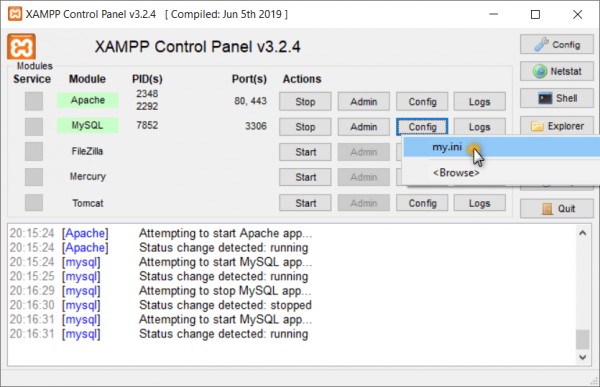What is SQL Injection ?
SQL injection is an attack/attempt of hacking. A SQL injection attack consists of insertion or “injection” of a SQL query via the input data from the client to the application. A successful SQL injection exploit can read sensitive data from the database, modify database data (Insert/Update/Delete), execute administration operations on the database (such as shutdown the DBMS), recover the content of a given file present on the DBMS file system and in some cases issue commands to the operating system. SQL injection attacks are a type of injection attack, in which SQL commands are injected into data-plane input in order to effect the execution of predefined SQL commands.
- SQL injection attacks allow attackers to spoof identity, tamper with existing data, cause repudiation issues such as voiding transactions or changing balances, allow the complete disclosure of all data on the system, destroy the data or make it otherwise unavailable, and become administrators of the database server.
- SQL Injection is very common with PHP and ASP applications due to the prevalence of older functional interfaces. Due to the nature of programmatic interfaces available, J2EE and ASP.NET applications are less likely to have easily exploited SQL injections.
- The severity of SQL Injection attacks is limited by the attacker’s skill and imagination, and to a lesser extent, defense in depth countermeasures, such as low privilege connections to the database server and so on. In general, consider SQL Injection a high impact severity.
SQL Injection Prevention
SQL Injection attacks are unfortunately very common, and this is due to two factors:
- the significant prevalence of SQL Injection vulnerabilities, and
- the attractiveness of the target (i.e., the database typically contains all the interesting/critical data for your application).
It’s somewhat shameful that there are so many successful SQL Injection attacks occurring, because it is EXTREMELY simple to avoid SQL Injection vulnerabilities in your code.
SQL Injection flaws are introduced when software developers create dynamic database queries that include user supplied input. To avoid SQL injection flaws is simple. Developers need to either: a) stop writing dynamic queries; and/or b) prevent user supplied input which contains malicious SQL from affecting the logic of the executed query.
This article provides a set of simple techniques for preventing SQL Injection vulnerabilities by avoiding these two problems. These techniques can be used with practically any kind of programming language with any type of database. There are other types of databases, like XML databases, which can have similar problems (e.g., XPath and XQuery injection) and these techniques can be used to protect them as well.
Recommended Protection:
- 1. Prepared Statements with Parameterized Queries
- 2. Stored Procedures
- 3. White List Input Validation
- 4. Escaping All User Supplied Input
Additional Protection:
- 5. Enforcing Least Privilege
- 6. Performing White List Input Validation as a Secondary Defense
- Unsafe Example
SQL injection flaws typically look like this:
The following (Java) example is UNSAFE, and would allow an attacker to inject code into the query that would be executed by the database. The unvalidated “customerName” parameter that is simply appended to the query allows an attacker to inject any SQL code they want. Unfortunately, this method for accessing databases is all too common.
String query = "SELECT account_balance FROM user_data WHERE user_name = "
+ request.getParameter("customerName");
try {
Statement statement = connection.createStatement( … );
ResultSet results = statement.executeQuery( query );
}
Recommended Protection
1. Prepared Statements (with Parameterized Queries)
The use of prepared statements with variable binding (aka parameterized queries) is how all developers should first be taught how to write database queries. They are simple to write, and easier to understand than dynamic queries. Parameterized queries force the developer to first define all the SQL code, and then pass in each parameter to the query later. This coding style allows the database to distinguish between code and data, regardless of what user input is supplied.
Prepared statements ensure that an attacker is not able to change the intent of a query, even if SQL commands are inserted by an attacker. In the safe example below, if an attacker were to enter the userID of tom’ or ‘1’=’1, the parameterized query would not be vulnerable and would instead look for a username which literally matched the entire string tom’ or ‘1’=’1.
Language specific recommendations:
- Java EE – use PreparedStatement() with bind variables
- .NET – use parameterized queries like SqlCommand() or OleDbCommand() with bind variables
- PHP – use PDO with strongly typed parameterized queries (using bindParam())
- Hibernate – use createQuery() with bind variables (called named parameters in Hibernate)
- SQLite – use sqlite3_prepare() to create a statement object
In rare circumstances, prepared statements can harm performance. When confronted with this situation, it is best to either a) strongly validate all data or b) escape all user supplied input using an escaping routine specific to your database vendor as described below, rather than using a prepared statement.
- Safe Java Prepared Statement Example
The following code example uses a PreparedStatement, Java’s implementation of a parameterized query, to execute the same database query.
String custname = request.getParameter("customerName"); // This should REALLY be validated too
// perform input validation to detect attacks
String query = "SELECT account_balance FROM user_data WHERE user_name = ? ";
PreparedStatement pstmt = connection.prepareStatement( query );
pstmt.setString( 1, custname);
ResultSet results = pstmt.executeQuery( );
- Safe C# .NET Prepared Statement Example
With .NET, it’s even more straightforward. The creation and execution of the query doesn’t change. All you have to do is simply pass the parameters to the query using the Parameters.Add() call as shown here.
String query =
"SELECT account_balance FROM user_data WHERE user_name = ?";
try {
OleDbCommand command = new OleDbCommand(query, connection);
command.Parameters.Add(new OleDbParameter("customerName", CustomerName Name.Text));
OleDbDataReader reader = command.ExecuteReader();
// …
} catch (OleDbException se) {
// error handling
}
We have shown examples in Java and .NET but practically all other languages, including Cold Fusion, and Classic ASP, support parameterized query interfaces. Even SQL abstraction layers, like the Hibernate Query Language (HQL) have the same type of injection problems (which we call HQL Injection). HQL supports parameterized queries as well, so we can avoid this problem:
- Hibernate Query Language (HQL) Prepared Statement (Named Parameters) Examples
First is an unsafe HQL Statement
Query unsafeHQLQuery = session.createQuery("from Inventory where productID='"+userSuppliedParameter+"'");
Here is a safe version of the same query using named parameters
Query safeHQLQuery = session.createQuery("from Inventory where productID=:productid");
safeHQLQuery.setParameter("productid", userSuppliedParameter);
For examples of parameterized queries in other languages, including Ruby, PHP, Cold Fusion, and Perl, see the Query Parameterization Cheat Sheet
Developers tend to like the Prepared Statement approach because all the SQL code stays within the application. This makes your application relatively database independent.
2. Stored Procedures
Stored procedures are not always safe from SQL injection. However, certain standard stored procedure programming constructs have the same effect as the use of parameterized queries when implemented safely* which is the norm for most stored procedure languages. They require the developer to just build SQL statements with parameters which are automatically parameterized unless the developer does something largely out of the norm. The difference between prepared statements and stored procedures is that the SQL code for a stored procedure is defined and stored in the database itself, and then called from the application. Both of these techniques have the same effectiveness in preventing SQL injection so your organization should choose which approach makes the most sense for you.
*Note: ‘Implemented safely’ means the stored procedure does not include any unsafe dynamic SQL generation. Developers do not usually generate dynamic SQL inside stored procedures. However, it can be done, but should be avoided. If it can’t be avoided, the stored procedure must use input validation or proper escaping as described in this article to make sure that all user supplied input to the stored procedure can’t be used to inject SQL code into the dynamically generated query. Auditors should always look for uses of sp_execute, execute or exec within SQL Server stored procedures. Similar audit guidelines are necessary for similar functions for other vendors.
There are also several cases where stored procedures can increase risk. For example, on MS SQL server, you have 3 main default roles: db_datareader, db_datawriter and db_owner. Before stored procedures came into use, DBA’s would give db_datareader or db_datawriter rights to the webservice’s user, depending on the requirements. However, stored procedures require execute rights, a role that is not available by default. Some setups where the user management has been centralized, but is limited to those 3 roles, cause all web apps to run under db_owner rights so stored procedures can work. Naturally, that means that if a server is breached the attacker has full rights to the database, where previously they might only have had read-access. More on this topic here. http://www.sqldbatips.com/showarticle.asp?ID=8
- Safe Java Stored Procedure Example
The following code example uses a CallableStatement, Java’s implementation of the stored procedure interface, to execute the same database query. The “sp_getAccountBalance” stored procedure would have to be predefined in the database and implement the same functionality as the query defined above.
String custname = request.getParameter("customerName"); // This should REALLY be validated
try {
CallableStatement cs = connection.prepareCall("{call sp_getAccountBalance(?)}");
cs.setString(1, custname);
ResultSet results = cs.executeQuery();
// … result set handling
} catch (SQLException se) {
// … logging and error handling
}
3. White List Input Validation
Various parts of SQL queries aren’t legal locations for the use of bind variables, such as the names of tables or columns, and the sort order indicator (ASC or DESC). In such situations, input validation or query redesign is the most appropriate defense. For the names of tables or columns, ideally those values come from the code, and not from user parameters. But if user parameter values are used to make different for table names and column names, then the parameter values should be mapped to the legal/expected table or column names to make sure unvalidated user input doesn’t end up in the query. Please note, this is a symptom of poor design and a full re-write should be considered if time allows. Here is an example of table name validation.
String tableName;
switch(PARAM):
case "Value1": tableName = "fooTable";
break;
case "Value2": tableName = "barTable";
break;
...
default : throw new InputValidationException("unexpected value provided for table name");
The tableName can then be directly appended to the SQL query since it is now known to be one of the legal and expected values for a table name in this query. Keep in mind that generic table validation functions can lead to data loss as table names are used in queries where they are not expected.
For something simple like a sort order, it would be best if the user supplied input is converted to a boolean, and then that boolean is used to select the safe value to append to the query. This is a very standard need in dynamic query creation. For example:
public String someMethod(boolean sortOrder) {
String SQLquery = "some SQL ... order by Salary " + (sortOrder ? "ASC" : "DESC");
...
Any time user input can be converted to a non-String, like a date, numeric, boolean, enumerated type, etc. before it is appended to a query, or used to select a value to append to the query, this ensures it is safe to do so.
Input validation is also recommended as a secondary defense in ALL cases, even when using bind variables as is discussed later in this article.
3. Escaping All User-Supplied Input
This technique should only be used as a last resort, when none of the above are feasible. Input validation is probably a better choice as this methodology is frail compared to other defenses and we cannot guarantee it will prevent all SQL Injection in all situations.
This technique is to escape user input before putting it in a query. It is very database specific in its implementation. It’s usually only recommended to retrofit legacy code when implementing input validation isn’t cost effective. Applications built from scratch, or applications requiring low risk tolerance should be built or re-written using parameterized queries, stored procedures, or some kind of Object Relational Mapper (ORM) that builds your queries for you.
This technique works like this. Each DBMS supports one or more character escaping schemes specific to certain kinds of queries. If you then escape all user supplied input using the proper escaping scheme for the database you are using, the DBMS will not confuse that input with SQL code written by the developer, thus avoiding any possible SQL injection vulnerabilities.
The OWASP Enterprise Security API (ESAPI) is a free, open source, web application security control library that makes it easier for programmers to write lower-risk applications. The ESAPI libraries are designed to make it easier for programmers to retrofit security into existing applications. The ESAPI libraries also serve as a solid foundation for new development.
ESAPI.encoder().encodeForSQL( new OracleCodec(), queryparam );
- The javadoc for ESAPI 2.x (Legacy) is available. This code was migrated to GitHub in November 2014.
- The legacy ESAPI for Java at GitHub helps understand existing use of it when Javadoc seems insufficient.
- An attempt at another ESAPI for Java GitHub has other approaches and no tests or concrete codecs.
To find the javadoc specifically for the database encoders, click on the ‘Codec’ class on the left hand side. There are lots of Codecs implemented. The two Database specific codecs are OracleCodec, and MySQLCodec.
Just click on their names in the ‘All Known Implementing Classes:’ at the top of the Interface Codec page.
At this time, ESAPI currently has database encoders for:
- Oracle
- MySQL (Both ANSI and native modes are supported)
Database encoders are forthcoming for:
- SQL Server
- PostgreSQL
If your database encoder is missing, please let us know.
Database Specific Escaping Details
If you want to build your own escaping routines, here are the escaping details for each of the databases that we have developed ESAPI Encoders for:
- Oracle
- SQL Server
- DB2
Oracle Escaping
This information is based on the Oracle Escape character information found here: http://www.orafaq.com/wiki/SQL_FAQ#How_does_one_escape_special_characters_when_writing_SQL_queries.3F
Escaping Dynamic Queries
To use an ESAPI database codec is pretty simple. An Oracle example looks something like:
ESAPI.encoder().encodeForSQL( new OracleCodec(), queryparam );
So, if you had an existing Dynamic query being generated in your code that was going to Oracle that looked like this:
String query = "SELECT user_id FROM user_data WHERE user_name = '" + req.getParameter("userID")
+ "' and user_password = '" + req.getParameter("pwd") +"'";
try {
Statement statement = connection.createStatement( … );
ResultSet results = statement.executeQuery( query );
}
You would rewrite the first line to look like this:
Codec ORACLE_CODEC = new OracleCodec();
String query = "SELECT user_id FROM user_data WHERE user_name = '" +
ESAPI.encoder().encodeForSQL( ORACLE_CODEC, req.getParameter("userID")) + "' and user_password = '"
+ ESAPI.encoder().encodeForSQL( ORACLE_CODEC, req.getParameter("pwd")) +"'";
And it would now be safe from SQL injection, regardless of the input supplied.
For maximum code readability, you could also construct your own OracleEncoder.
Encoder oe = new OracleEncoder();
String query = "SELECT user_id FROM user_data WHERE user_name = '"
+ oe.encode( req.getParameter("userID")) + "' and user_password = '"
+ oe.encode( req.getParameter("pwd")) +"'";
With this type of solution, you would need only to wrap each user-supplied parameter being passed into an ESAPI.encoder().encodeForOracle( ) call or whatever you named the call and you would be done.
Turn off character replacement
Use SET DEFINE OFF or SET SCAN OFF to ensure that automatic character replacement is turned off. If this character replacement is turned on, the & character will be treated like a SQLPlus variable prefix that could allow an attacker to retrieve private data.
See http://download.oracle.com/docs/cd/B19306_01/server.102/b14357/ch12040.htm#i2698854 and http://stackoverflow.com/questions/152837/how-to-insert-a-string-which-contains-an for more information
Escaping Wildcard characters in Like Clauses
The LIKE keyword allows for text scanning searches. In Oracle, the underscore ‘_’ character matches only one character, while the ampersand ‘%’ is used to match zero or more occurrences of any characters. These characters must be escaped in LIKE clause criteria. For example:
SELECT name FROM emp WHERE id LIKE '%/_%' ESCAPE '/';
SELECT name FROM emp WHERE id LIKE '%\%%' ESCAPE '\';
Oracle 10g escaping
An alternative for Oracle 10g and later is to place { and } around the string to escape the entire string. However, you have to be careful that there isn’t a } character already in the string. You must search for these and if there is one, then you must replace it with }}. Otherwise that character will end the escaping early, and may introduce a vulnerability.
MySQL Escaping
MySQL supports two escaping modes:
- ANSI_QUOTES SQL mode, and a mode with this off, which we call
- MySQL mode.
ANSI SQL mode: Simply encode all ‘ (single tick) characters with ” (two single ticks)
MySQL mode, do the following:
NUL (0x00) --> \0 [This is a zero, not the letter O] BS (0x08) --> \b TAB (0x09) --> \t LF (0x0a) --> \n CR (0x0d) --> \r SUB (0x1a) --> \Z " (0x22) --> \" % (0x25) --> \% ' (0x27) --> \' \ (0x5c) --> \\ _ (0x5f) --> \_ all other non-alphanumeric characters with ASCII values less than 256 --> \c where 'c' is the original non-alphanumeric character.
This information is based on the MySQL Escape character information found here: https://dev.mysql.com/doc/refman/5.7/en/string-literals.html
SQL Server Escaping
We have not implemented the SQL Server escaping routine yet, but the following has good pointers and links to articles describing how to prevent SQL injection attacks on SQL server
Escaping SQLi in PHP
Use prepared statements and parameterized queries. These are SQL statements that are sent to and parsed by the database server separately from any parameters. This way it is impossible for an attacker to inject malicious SQL.
You basically have two options to achieve this:
1. Using PDO (for any supported database driver):
$stmt = $pdo->prepare('SELECT * FROM employees WHERE name = :name');
$stmt->execute(array('name' => $name));
foreach ($stmt as $row) {
// do something with $row
}
2. Using MySQLi (for MySQL):
$stmt = $dbConnection->prepare('SELECT * FROM employees WHERE name = ?');
$stmt->bind_param('s', $name);
$stmt->execute();
$result = $stmt->get_result();
while ($row = $result->fetch_assoc()) {
// do something with $row
}
PDO is the universal option. If you’re connecting to a database other than MySQL, you can refer to a driver-specific second option (e.g. pg_prepare() and pg_execute() for PostgreSQL).
































One Comment
Pingback: Security Tips to Protect Website from Hackers | 100Utils